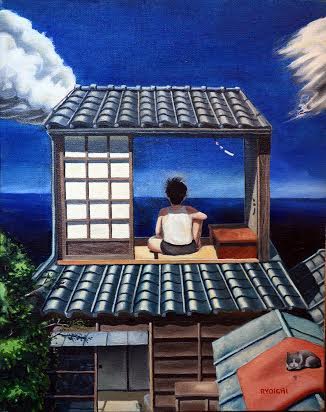
Anders Corr/Kyoko Sato: Dreamy scapes of oil paint
 “Summer Winds” (oil on canvas, 1984), by RYOICHI MIURA. Courtesy of Kamakura Shirts Collection, Kanagawa, Japan.
“Summer Winds” (oil on canvas, 1984), by RYOICHI MIURA. Courtesy of Kamakura Shirts Collection, Kanagawa, Japan.
A boy sits on a miniscule tatami (a mat) on the second floor of a miniature house, gazing at the Pacific Ocean. A kitten sleeps on a pillow. Sounds of waves and wind chimes wash over a bicycle and tobacco box obscured by shadow on the ground floor. It’s a summer day in Japan.
The self-taught painter Ryoichi Miura (b. Japan 1956-) dreamed, in black and white, the scene painted in “Summer Winds”. He met us last week at the Harvard Club of New York City and over a summertime special of chilled avocado soup recounted his inspiration for the painting. “I wanted to color the scene. It was so unique to me because I had never seen a monochrome dream”. He just closed the show “Summer: Gallery and Invited Artists” (July 28-Aug. 15) at the Prince Street Gallery in New York.
A dreamy, deformé style epitomizes Ryoichi’s paintings. His signature and contemporary aesthetic is rooted in Garo, a monthly manga (comics) magazine (Seirindo, Japan, 1964-2002). “A big brother of my friend showed me the issue of July 1968 when I visited their home. I saw Ernest Hemingway’s The Killers, a comic {book} by Maki Sasaki. I was totally shocked and I could not move at all!”
Miura immediately asked his mother to subscribe to the magazine. When the bookstore hand-delivered his first issue, as was the norm in the 1960s, Miura jumped from the bathtub and ran dripping, merely covered by a towel, to receive it from the delivery man.
Ryoichi became an artist from that point. He drew his first manga, and brought it to school. His teacher read it aloud in the classroom. He still feels pride that everyone in the classroom, including his teacher, admired the art. Miura painted his first oil painting when he was 13, and has painted ever since. One of his earliest paintings still hangs in the principal’s room of his junior high school, Miura proudly recounts, 46 years later. Miura is now 59.
The earliest influence from manga is delightfully visible in his current art. Illustrations in his children’s book, Kids in N.Y. (Kaiseisha, Japan, 2003), are eerily angled, imbalanced, falling. “New York City is always moving. I wanted to express its movement and speed of the city.”
Miura is the Edward Hopper (American, 1882-1967) of his moment in New York City. Like Hopper, Miura’s paintings are lonely, urban, stark, transitory, estranged, anxious and tightly cropped. Yet Miura is hotter, faster, and more emotional.
Miura, above all, wants to communicate emotion. “I see a scene that gives me an emotional response,” he said. “I want the viewers of my paintings to feel this moment of emotion, the color, the movement.” His medium is important to his message. “I can express it [emotion, color, and movement] only because I am using oil, not camera.” Only with oil and the texture of paint, for example, does he believe that he could paint the smile of a woman, what became his favorite painting, in vermillion red. He says he will never be able to paint such a piece again, and has refused to sell it to buyers.
Ms. Tamiko Sadasue purchased “Summer Winds” in 2013 at the Prince Street Gallery because it symbolizes old Japan – a simpler time after World War II when she was a young girl and Japan had a dream. The painting hangs in Kanagawa Japan at the head office of her company, Kamakura Shirts, as a symbol of Japan’s dream of a prosperous future linked to a simpler, Hopperesque past.
While other artists chase new media, Miura sees value in the classical medium of oil. “I need to wait for 2 weeks for drying, always takes long, need to make tremendous efforts to finish a work. That is valuable for me, especially because we are living in such a convenient world,” says Miura. “I have many more objects and themes I want to paint. Through my paintings, I would like to show my own worlds with my own colors and textures to the people.“
Miura’s dream of painting color into the black and white, proceeds apace with the speed of New York City.
Anders Corr, Ph.D., founded Corr Analytics in 2013. Ms. Kyoko Sato is a curator in New York City.